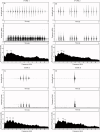Vocal repertoire of Microhyla nilphamariensis from Delhi and comparison with closely related M. ornata populations from the western coast of India and Sri Lanka
- PMID: 38562993
- PMCID: PMC10984171
- DOI: 10.7717/peerj.16903
Vocal repertoire of Microhyla nilphamariensis from Delhi and comparison with closely related M. ornata populations from the western coast of India and Sri Lanka
Abstract
Advertisement calls in frogs have evolved to be species-specific signals of recognition and are therefore considered an essential component of integrative taxonomic approaches to identify species and delineate their distribution range. The species rich genus Microhyla is a particularly challenging group for species identification, discovery and conservation management due to the small size, conserved morphology and wide distribution of its members, necessitating the need for a thorough description of their vocalization. In this study, we provide quantitative description of the vocal behaviour of Microhyla nilphamariensis, a widely distributed south Asian species, from Delhi, India, based on call recordings of 18 individuals and assessment of 21 call properties. Based on the properties measured acrossed 360 calls, we find that a typical advertisement call of M. nilphamariensis lasts for 393.5 ± 57.5 ms, has 17 pulses on average and produce pulses at rate of 39 pulses/s. The overall call dominant frequency was found to be 2.8 KHz and the call spectrum consisted of two dominant frequency peaks centered at 1.6 KHz and 3.6 KHz, ranging between 1.5-4.1 KHz. Apart from its typical advertisement call, our study also reveals the presence of three 'rare' call types, previously unreported in this species. We describe variability in call properties and discuss their relation to body size and temperature. We found that overall dominant frequency 1 (spectral property) was found to be correlated with body size, while first pulse period (temporal property) was found to be correlated with temperature. Further, we compare the vocal repertoire of M. nilphamariensis with that of the congener Microhyla ornata from the western coast of India and Sri Lanka and also compare the call properties of these two populations of M. ornata to investigate intra-specific call variation. We find statistically significant differentiation in their acoustic repertoire in both cases. Based on 18 call properties (out of 20), individuals of each locality clearly segregate on PCA factor plane forming separate groups. Discriminant function analysis (DFA) using PCA factors shows 100% classification success with individuals of each locality getting classified to a discrete group. This confirms significant acoustic differentiation between these species as well as between geographically distant conspecifics. The data generated in this study will be useful for comparative bioacoustic analysis of Microhyla species and can be utilized to monitor populations and devise conservation management plan for threatened species in this group.
Keywords: Amphibia; Anura; Bioacoustics; Call diversity; Distribution; Indian subcontinent; Microhylidae; Urban ecology.
©2024 Srigyan et al.
Conflict of interest statement
The authors declare there are no competing interests.
Figures




References
-
- Angulo A, Icochea J. Cryptic species complexes, widespread species and conservation: lessons from Amazonian frogs of the Leptodactylus marmoratus group (Anura: Leptodactylidae) Systematics and Biodiversity. 2010;8:357–370. doi: 10.1080/14772000.2010.507264. - DOI
-
- Baker JMR. Body condition and tail height in great crested newts, Triturus cristatus. Animal Behaviour. 1992;43:157–159. doi: 10.1016/S0003-3472(05)80081-8. - DOI
-
- Bedi A, Bedi V, Nag S, Suyesh R. Wild observations of the reproductive behaviour and first evidence of vocalization in Crocodile newt Tylototriton himalayanus (Caudata: Salamandridae) from the Himalayan biodiversity hotspot in Eastern India. Salamandra. 2021;57:65–74.
-
- Bee MA, Cook JM, Love EK, O’Bryan LR, Pettitt BA, Schrode K, Vélez A. Assessing Acoustic signal variability and the potential for sexual selection and social recognition in Boreal Chorus Frogs (Pseudacris maculata): patterns of individual variation in Boreal Chorus Frog advertisement calls. Ethology. 2010;116:564–576. doi: 10.1111/j.1439-0310.2010.01773.x. - DOI
MeSH terms
LinkOut - more resources
Full Text Sources
Miscellaneous

